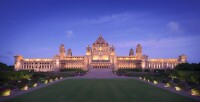Sudhir Samal Review of Taj Umaid Bhavan Palace
Umaid Bhawan Palace, located at Jodhpur in Rajasth...
Umaid Bhawan Palace, located at Jodhpur in Rajasthan, India, is one of the world's largest private residences. A part of the palace is managed by Taj Hotels. Named after Maharaja Umaid Singh, grandfather of the present owner Gaj Singh of the palace, this edifice has 347 rooms and serves as the principal residence of the erstwhile Jodhpur royal family. A part of the palace also houses a museum.
Ground for the foundations of the building was broken on 18 November 1929 by Maharaja Umaid Singh and the construction work was completed in 1943. The Palace was built to provide employment to thousands of people during the time of famine.
Umaid Bhawan Palace is linked to a curse by a saint who had said that a period of drought will follow the good rule of the Rathore Dynasty. Thus, after the end of about 50-year reign of Pratap Singh, Jodhpur faced a severe drought and famine conditions in the 1920s for a period of three consecutive years. The farmers of the area faced with famine conditions sought the help of the then king Umaid Singh,[3] who was the 37th Rathore ruler of Marwar at Jodhpur,[4] to provide them with some employment so that they could survive the famine conditions. The king, in order to help the farmers, decided to build a lavish palace. He commissioned Henry Vaughan Lanchester as the architect to prepare the plans for the palace; Lanchester was a contemporary of Sir Edwin Lutyens who planned the buildings of the New Delhi government complex. Lanchester patterned the Umaid Palace on the lines of the New Delhi building complex by adopting the theme of domes and columns.[3] The palace was designed as an extraordinary blend of western technology, and many Indian architectural features.[4]
The palace was built at a slow pace as its initial objective was to provide employment to the famine-stricken farmers of the locale. The foundation stone was laid in 1929. About 2,000 to 3,000 people were employed to build it.[5] However, the actual occupation of the palace by the Maharaja came only after its completion in 1943, very close to the period of Indian Independence. There was criticism in some quarters for embarking on an expensive project but it had served the main purpose of helping the citizens of Jodhpur to face the famine situation.[3] The estimated cost of building the palace was Rs 11 million.[6] When it opened its gilded doors in 1943 it was considered as one of the largest royal residences in the world.[4]
Umaid Bhawan Palace as seen from Mehrangarh Fort
The site chosen for the palace was on a hill known as Chittar hill in the outer limits of Jodhpur, [7] after which the palace is also known,[8] where no water supply was available near by and hardly any vegetation grew as hill slopes were rocky. The building material required was not close by as sandstone quarries were at quite a distance. Since the Maharaja had the foresight to bring his project to fruition, he built a railway line to the quarry site to transport the building material. Donkeys were inducted to haul soil to the site. The sandstone transported by rail was dressed at site into large blocks with interlocking joints so that they could be laid without the use of mortar and thus create a wonderful edifice.

Comments: